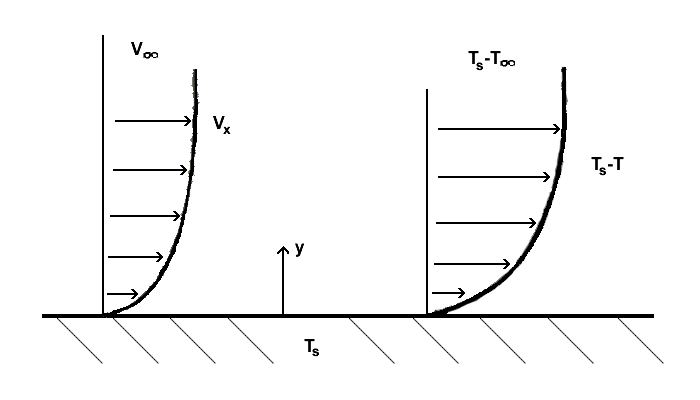 | ||
In heat transfer at a boundary (surface) within a fluid, the Nusselt number (Nu) is the ratio of convective to conductive heat transfer across (normal to) the boundary. In this context, convection includes both advection and diffusion. Named after Wilhelm Nusselt, it is a dimensionless number. The conductive component is measured under the same conditions as the heat convection but with a (hypothetically) stagnant (or motionless) fluid. A similar non-dimensional parameter is Biot Number, with the difference that the thermal conductivity is of the solid body and not the fluid.
Contents
- Introduction
- Derivation
- Empirical Correlations
- Free convection at a vertical wall
- Free convection from horizontal plates
- Flat plate in laminar flow
- Gnielinski correlation
- Dittus Boelter equation
- Sieder Tate correlation
- Forced convection in fully developed laminar pipe flow
- Convection with uniform surface heat flux for circular tubes
- Convection with uniform surface temperature for circular tubes
- References
A Nusselt number close to one, namely convection and conduction of similar magnitude, is characteristic of "slug flow" or laminar flow. A larger Nusselt number corresponds to more active convection, with turbulent flow typically in the 100–1000 range.
The convection and conduction heat flows are parallel to each other and to the surface normal of the boundary surface, and are all perpendicular to the mean fluid flow in the simple case.
where h is the convective heat transfer coefficient of the flow, L is the characteristic length, k is the thermal conductivity of the fluid.
In contrast to the definition given above, known as average Nusselt number, local Nusselt number is defined by taking the length to be the distance from the surface boundary to the local point of interest.
The mean, or average, number is obtained by integrating the expression over the range of interest, such as:
The mass transfer analog of the Nusselt number is the Sherwood number.
Introduction
An understanding of convection boundary layers is necessary to understanding convective heat transfer between a surface and a fluid flowing past it. A thermal boundary layer develops if the fluid free stream temperature and the surface temperatures differ. A temperature profile exists due to the energy exchange resulting from this temperature difference.
The heat transfer rate can then be written as,
And because heat transfer at the surface is by conduction,
These two terms are equal; thus
Rearranging,
Making it dimensionless by multiplying by representative length L,
The right hand side is now the ratio of the temperature gradient at the surface to the reference temperature gradient. While the left hand side is similar to the Biot modulus. This becomes the ratio of conductive thermal resistance to the convective thermal resistance of the fluid, otherwise known as the Nusselt number, Nu.
Derivation
The Nusselt number may be obtained by a non dimensional analysis of Fourier's law since it is equal to the dimensionless temperature gradient at the surface:
Indeed, if:
we arrive at
then we define
so the equation becomes
By integrating over the surface of the body:
where
Empirical Correlations
Typically, for free convection, the average Nusselt number is expressed as a function of the Rayleigh number and the Prandtl number, written as:
Otherwise, for forced convection, the Nusselt number is generally a function of the Reynolds number and the Prandtl number, or
Empirical correlations for a wide variety of geometries are available that express the Nusselt number in the aforementioned forms.
Free convection at a vertical wall
Cited as coming from Churchill and Chu:
Free convection from horizontal plates
If the characteristic length is defined
where
Then for the top surface of a hot object in a colder environment or bottom surface of a cold object in a hotter environment
And for the bottom surface of a hot object in a colder environment or top surface of a cold object in a hotter environment
Forced convection on flat plate
Flat plate in laminar flow
The local Nusselt number for laminar flow over a flat plate is given by
The average Nusselt number for laminar flow over a flat plate is given by
Gnielinski correlation
Gnielinski's correlation for turbulent flow in tubes:
where f is the Darcy friction factor that can either be obtained from the Moody chart or for smooth tubes from correlation developed by Petukhov:
The Gnielinski Correlation is valid for:
Dittus-Boelter equation
The Dittus-Boelter equation (for turbulent flow) is an explicit function for calculating the Nusselt number. It is easy to solve but is less accurate when there is a large temperature difference across the fluid. It is tailored to smooth tubes, so use for rough tubes (most commercial applications) is cautioned. The Dittus-Boelter equation is:
where:
The Dittus-Boelter equation is valid for
Example The Dittus-Boelter equation is a good approximation where temperature differences between bulk fluid and heat transfer surface are minimal, avoiding equation complexity and iterative solving. Taking water with a bulk fluid average temperature of 20 °C, viscosity 10.07×10−4 Pa·s and a heat transfer surface temperature of 40 °C (viscosity 6.96×10−4, a viscosity correction factor for
Sieder-Tate correlation
The Sieder-Tate correlation for turbulent flow is an implicit function, as it analyzes the system as a nonlinear boundary value problem. The Sieder-Tate result can be more accurate as it takes into account the change in viscosity (
where:
The Sieder-Tate correlation is valid for
Forced convection in fully developed laminar pipe flow
For fully developed internal laminar flow, the Nusselt numbers are constant-valued. The values depend on the hydraulic diameter.
For internal Flow:
where:
Dh = Hydraulic diameterkf = thermal conductivity of the fluidh = convective heat transfer coefficientConvection with uniform surface heat flux for circular tubes
From Incropera & DeWitt,
Convection with uniform surface temperature for circular tubes
For the case of constant surface temperature,
